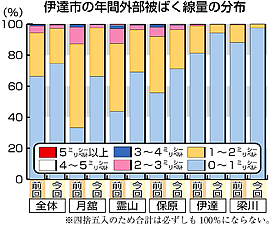05. 2014年8月30日 11:06:03
: RRUE34wrBQ
福島県に住んでいる皆さん、だまされてはいけません。ウクライナのジトームィル州における1986-2005年までの20年間の被曝線量の総計は、6.0mSvにすぎない。(Bandjevski Y.I. et al. Tchernobyl,
25 ans apres. 20ページ) http://www.asyura2.com/14/genpatu37/msg/315.html#c4 すなわち、年間線量は、0.3mSvだ。 そのジトームィル州で、何が起きたのか、書きます。 >ジトームィル州では、事故後、最初の10年で、成人の血液並びに骨髄組織の50倍以上に、0.2%から11.5%に増加した。 For the first 10 years after the catastrophe
the number of cases of diseases of blood
and blood-forming organs among adults in the
contaminated territories of Zhytomir Province
increased more than 50-fold: from 0.2 up to
11.5% (Nagornaya, 1995). >事故当時、6-8歳であった、ヴィーンヌィツャ州とジトームィル州に住む子どもたち3019人の35.7%に、甲状腺の変異が認められた。 Thyroid gland changes were found in
35.7% of 3,019 teenagers living in Vinnitsa and
Zhytomir provinces who had been 6 to 8 years
old at the time of the catastrophe (Fedyk, 2000). >顎顔面の先天異常発生率(大部分は上唇裂と口蓋裂)のピークは、1986年4月26日から、9か月以内に生まれた子どもに生じた。6-10倍の発生率は、汚染された地域(キエフ市、キエフ州、ジトームィル州)では、その他の地域(ヴィーンヌィツャ州、フメリヌィーツィクィイ州)に比べて普通のことになった。 The highest incidence of maxillofacial
CMs (mostly cleft upper lip and palate) occurred
in children born within 9 months after
April 26, 1986, and was six- to tenfold more
common in the more contaminated areas of
Kiev City and Kiev and Zhytomir provinces
compared with the less contaminated provinces
of Vinnitsa and Khmelnitsk (Nyagu et al.,
1998). >ジトームィル州に住む成人では、がんの発生率が、1986-1994年の間に、3倍近くなった。すなわち1.34%から3.91%になった。 For adults in the contaminated districts of
Zhytomir Province cancer morbidity increased
nearly threefold in 1986–1994: from 1.34 to
3.91% (Nagornaya, 1995). >事故以前には、子どもと成人の甲状腺がん発生率は、10万人あたり0.09人だった。事故後、1990年に、それは、10万人あたり0.57-0.63人になった。最大の発生率は、最も高濃度に汚染された、・・・ジトームィル州・・・に住む若者で記録された。 Before the catastrophe, the occurrence of
thyroid cancer among children and adolescents
was 0.09 per 100,000; afterward, in 1990, it was
0.57–0.63 per 100,000. The greatest increase
in morbidity was recorded in young people living
in the most heavily contaminated districts
of Kiev, Chernygov, Zhytomir, Cherkassk, and
Rovno provinces (Komissarenko et al., 1995). >白血病の発生率に関して、汚染されたジトームィル州で、胎内被曝し、1986年に生まれた子どもたちと、より汚染されていないポルトヴァ州の子どもたちを比較すると、累積発生率に基づくリスクの割合は、すべての白血病の種類(2.7)と急性リンパ芽球性白血病(3.4)で有意な増加を示した。 Leukemia incidence in 1986–1996 among
Ukrainian children born in 1986 and thus ex-
posed in utero in the contaminated areas of
Zhytomir Province was compared with children
born in the less contaminated Poltava
Province. Risk ratios based on cumulative
incidence show significant increases for all
leukemia (rate ratio: 2.7, 95% CI: 1.9–3.8) and
for acute lymphoblastic leukemia (rate ratio:
3.4, 95% CI: 1.1–10.4; Noshchenko et al., 2001,
2002). >最も汚染された、ジトームィル州とキエフ州の4つの区域では、事故以前と1999-2000年を比べると、悪性の血液病が有意に増加した。 During the first 4 years after the catastrophe,
malignant blood diseases were significantly
higher in the four most contaminated
districts of Zhytomir and Kiev provinces
compared with the pre-Chernobyl period and
1999–2000 (Figure 6.19). >ジトームィル州とキエフ州では、周産期死亡、死産、新生児死亡数が、事故後、1年目と3年目に顕著に高かった。後者の増加は、汚染された地元産を食べたことに関係があるかもしれない。 1. Perinatal mortality, stillbirth rate, and
early neonatal mortality in Zhytomir and Kiev
provinces were noticeably higher in the first
year after the catastrophe and again 3 years
later (Figure 7.11). The latter increase may be
connected to consumption of locally contaminated
food. >周産期死亡に関して、最も汚染されたウクライナの地方(ジトームィル州、キエフ州、キエフ市)では、他のウクライナの地方と比べると、有意な、より高い傾向を示す。 Comparison of perinatal mortality in
the most contaminated regions of Ukraine
(Zhytomir and Kiev provinces and Kiev City)
with the mortality in the rest of Ukraine
shows significantly higher figures 1991–1999
(Figure 7.12).
|


 スパムメールの中から見つけ出すためにメールのタイトルには必ず「阿修羅さんへ」と記述してください。
スパムメールの中から見つけ出すためにメールのタイトルには必ず「阿修羅さんへ」と記述してください。 スパムメールの中から見つけ出すためにメールのタイトルには必ず「阿修羅さんへ」と記述してください。
スパムメールの中から見つけ出すためにメールのタイトルには必ず「阿修羅さんへ」と記述してください。